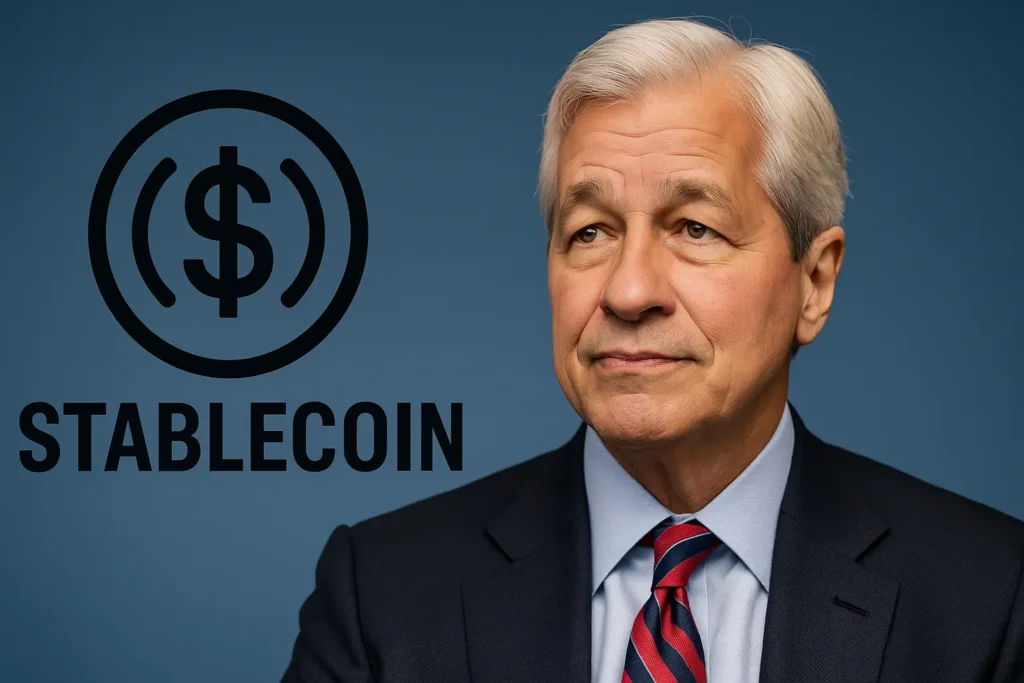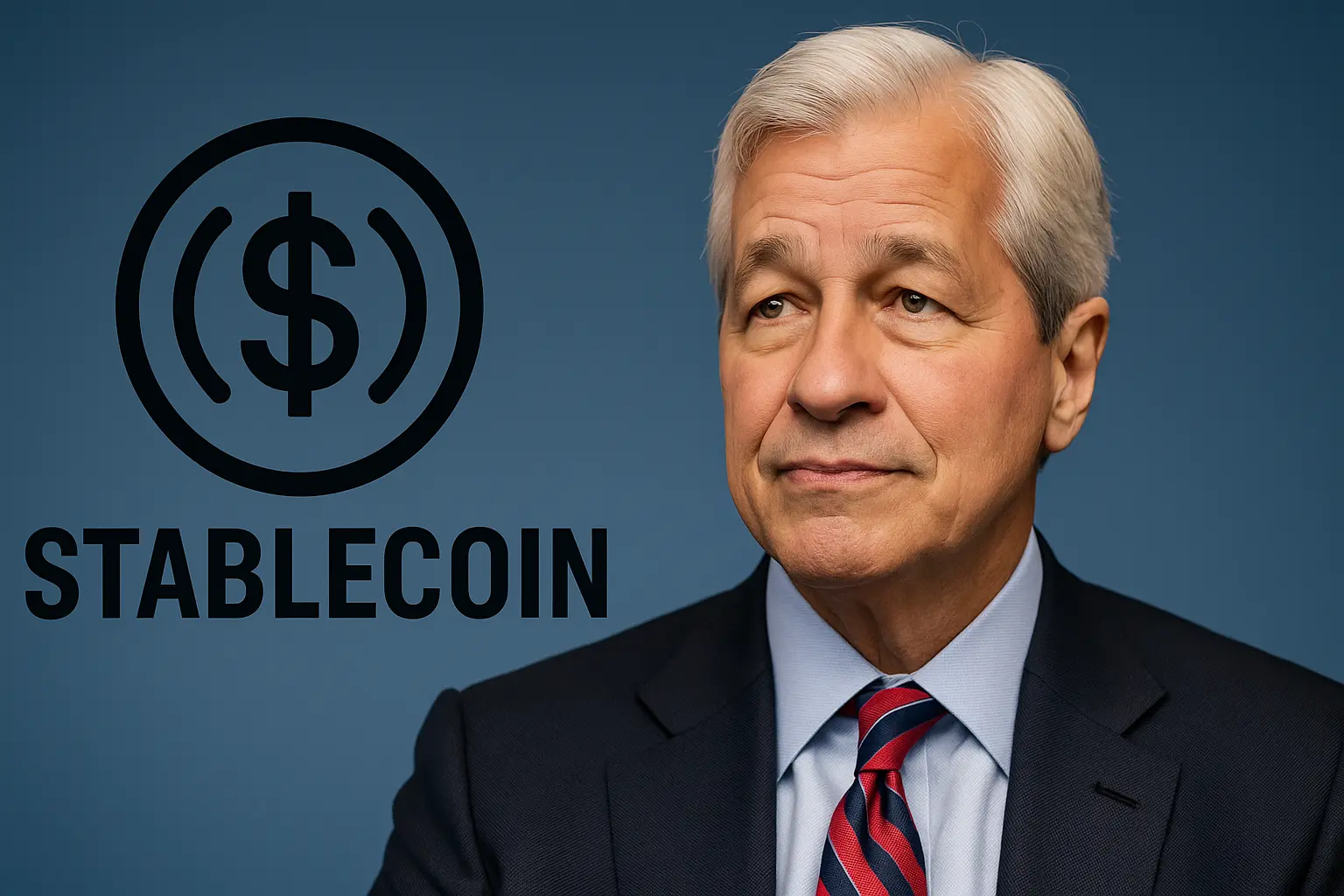JPMorgan CEO Jamie Dimon announces plans to enter the stablecoin market as fintech competition rises. Discover how this move could reshape banking, digital payments, and the future of crypto finance in the U.S.
“If you can’t beat them, join them — or at least build your own version.”
In a move that’s both bold and overdue, Jamie Dimon, the CEO of JPMorgan Chase, has finally opened the door for America’s largest bank to dive into the world of stablecoins — signaling a significant shift in how traditional finance is adapting to the fintech revolution.
With fintech companies growing rapidly and pushing the boundaries of what modern banking can be, the pressure has mounted for legacy institutions to evolve. And now, JPMorgan Chase — the largest bank in the U.S. by assets — is taking the plunge.
Let’s break down what this move means for Wall Street, Main Street, crypto markets, and most importantly, you — the everyday American investor and consumer.
💡 What Are Stablecoins, and Why Do They Matter?
Before we dive into Dimon’s announcement, let’s get clear on what stablecoins are and why they’ve become a hot topic on Wall Street and in Washington.
🔹 Stablecoins 101:
Stablecoins are digital currencies pegged to a stable asset, usually the U.S. dollar. Unlike volatile cryptocurrencies like Bitcoin or Ethereum, stablecoins aim to maintain a 1:1 value ratio with fiat currencies, making them ideal for:
- Payments
- Remittances
- Trading pairs on crypto exchanges
- Hedging against volatility
Think of them as the bridge between traditional money and digital finance.
Some of the most well-known stablecoins include:
- USDC (USD Coin) – backed by Coinbase and Circle
- USDT (Tether) – widely used but often controversial
- DAI – decentralized, backed by crypto collateral
🧠 Why JPMorgan Is Paying Attention Now
So, why is Jamie Dimon — who has famously bashed Bitcoin and crypto in the past — now warming up to stablecoins?
1. Fintech Is Gaining Ground
Fintech startups like Revolut, Stripe, SoFi, and Block (formerly Square) are redefining payments, savings, and investment. They’re fast, user-friendly, and increasingly integrated with crypto.
These companies are eroding the moat that big banks once had.
2. Demand for Digital Dollars
More consumers and businesses want instant, borderless transactions. Stablecoins offer this — and banks like JPMorgan can’t afford to ignore the demand much longer.
3. Crypto Isn’t Going Away
Despite market volatility, the digital asset space continues to grow. Major institutional players like BlackRock, Fidelity, and Visa have all taken steps into the crypto ecosystem.
Dimon may not like Bitcoin, but he knows stablecoins are becoming infrastructure.
🗣️ What Jamie Dimon Actually Said
Speaking at a recent financial conference, Dimon said:
“We are exploring the use of a JPMorgan-backed stablecoin. We’ve already proven the concept with JPM Coin, but we’re looking at broader retail applications now.”
He further added:
“Fintech competition is real. We don’t underestimate them. We plan to compete aggressively.”
That’s a rare admission from one of the most powerful figures in global finance — and it underscores how serious the stablecoin game has become.
🏦 A Quick Look Back: JPM Coin and Onyx
JPMorgan isn’t entirely new to blockchain. In fact, they’ve been testing and using a private digital coin called JPM Coin since 2019 — but only for internal transactions between institutional clients.
Their Onyx blockchain platform, launched in 2020, facilitates billions in daily value transfers between corporate accounts.
However, this new announcement signals a potential move into the public or retail stablecoin space — meaning everyday people, small businesses, and fintech partners could soon access JPMorgan’s version of a stablecoin.

🔍 The Fintech Threat: Why JPMorgan Is on Alert
Jamie Dimon isn’t paranoid — he’s being practical.
Fintech companies are nipping at the heels of traditional banks. Consider this:
- Cash App and Venmo now handle billions in peer-to-peer payments.
- Robinhood has brought millions of young investors into the markets.
- Crypto exchanges like Coinbase are handling more capital from millennials than some regional banks.
Even Apple and Google are slowly becoming financial super-apps, offering credit cards, BNPL (buy now, pay later), and more.
The result? Banks are losing mindshare — and market share — especially among younger Americans.
🌐 What a JPMorgan Stablecoin Could Look Like
Based on available information and market trends, here’s what we might expect from a JPMorgan stablecoin:
| Feature | Likely Characteristics |
|---|---|
| Name | JPM Coin (Retail) or JPM Dollar |
| Backing | Fully backed 1:1 by U.S. dollars or short-term Treasuries |
| Network | Likely built on Ethereum or a private blockchain |
| Use Case | Peer-to-peer payments, cross-border transactions, merchant settlement |
| Regulation | Heavily compliant with U.S. banking laws and SEC oversight |
Unlike decentralized stablecoins, JPMorgan’s product would be centrally issued, regulated, and fully auditable — giving it a credibility boost in Washington and on Wall Street.
💰 High Stakes for Revenue and Market Control
Make no mistake — this move isn’t just about innovation. It’s about revenue protection and future-proofing.
JPMorgan’s Key Revenue Drivers at Risk:
- Cross-border fees
- Corporate payments
- Consumer banking and transfers
- Custody services
If fintech and stablecoins continue to eat into these verticals, JPMorgan could lose billions in annual profits.
Launching a stablecoin now is about locking in dominance before the ground shifts permanently.
🧾 Regulation: The Elephant in the Room
One major obstacle to widespread stablecoin use is regulatory uncertainty.
The U.S. Congress, SEC, and Federal Reserve are still debating:
- Who should oversee stablecoins?
- Should banks be the only issuers?
- What kind of disclosures are required?
JPMorgan entering this space could accelerate regulatory clarity — or stir up even more questions.
But here’s the thing: Big banks have lobbying power, and if Jamie Dimon is all-in, you can bet regulators will take the proposal seriously.
📈 What This Means for Investors and Consumers
If you’re an investor, here’s what you need to watch:
📌 For Investors:
- Traditional banks may become more crypto-integrated
- Fintech stocks could see increased competition
- Crypto infrastructure providers (like Ethereum or Circle) may benefit from partnerships
📌 For Consumers:
- Expect faster, cheaper payments in the near future
- More banks may begin offering digital wallet services
- You might be able to send dollars instantly across borders, 24/7
💬 Reactions from the Industry
Here’s how different voices in the financial world are reacting:
🔹 Brian Armstrong (CEO, Coinbase):
“If JPMorgan enters the stablecoin race, it validates the work we’ve been doing with USDC for years.”
🔹 Elizabeth Warren (U.S. Senator):
“Banks must play by the same rules as everyone else. A stablecoin by JPMorgan raises serious regulatory questions.”
🔹 Nouriel Roubini (Economist):
“Private stablecoins will dominate — but only the ones backed by strong institutions. JPMorgan has the firepower.”
🧠 Final Thoughts: A Tectonic Shift in Banking?
Jamie Dimon’s comments mark more than a strategy update — they represent a seismic shift in how banks view money in the digital age.
We’re moving toward a world where:
- Digital dollars flow 24/7
- Fintech and banking collide
- Stablecoins become financial infrastructure
Whether you’re a crypto skeptic or a blockchain believer, one thing is clear: If JPMorgan is jumping in, stablecoins are no longer fringe tech.
This is the beginning of mainstream adoption, and it’s moving faster than many expected.
📌 TL;DR – Quick Summary
- Jamie Dimon confirms JPMorgan will enter the stablecoin space amid fintech competition.
- The bank may expand its JPM Coin or launch a retail-friendly digital dollar.
- Fintech growth, payment innovation, and crypto adoption are forcing traditional banks to adapt.
- Regulatory clarity remains uncertain, but big banks may accelerate policy discussions.
- Consumers can expect faster, digital-first banking experiences in the near future.

Also Check This Post
Baird Upgrades This Fintech Stock, Calls for More Than 30% Upside — Should You Buy Now?
